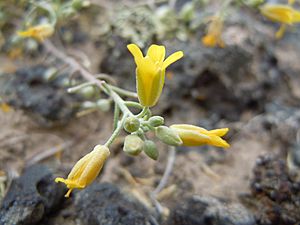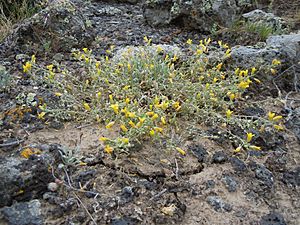Physaria ludoviciana facts for kids
Quick facts for kids Physaria ludoviciana |
|
|---|---|
 |
|
| Scientific classification | |
| Genus: |
Physaria
|
| Species: |
ludoviciana
|
| Synonyms | |
|
List
|
|
The Physaria ludoviciana is a special flowering plant. It is often called the bladder pod, silver bladderpod, or foothill bladderpod. This plant is part of the mustard family, known as Brassicaceae. It used to have a different scientific name, Lesquerella ludoviciana, but that name is now considered an older version.
What Does the Bladderpod Look Like?
The Physaria ludoviciana is a plant that lives for many years. It has a main root that grows deep into the ground, like a carrot. This plant usually grows to be about 6 to 16 inches tall.
Its flowers have four green parts called sepals. They also have four bright yellow petals and six stamens, which are the parts that make pollen.
The leaves of the bladderpod are simple and narrow. They are covered with tiny, star-shaped hairs. These hairs make the leaves look a bit silvery. The leaves at the bottom of the plant grow in a circle, like a rose.
After the flowers bloom, the plant makes round fruits. These fruits have two sections inside. They are also covered with many tiny hairs, just like the leaves. The plant usually flowers from early spring until mid or late summer. Some of these plants have extra sets of chromosomes, which means they are polyploids.
Where Does the Bladderpod Live?
The Physaria ludoviciana plant is in trouble in some places. It is considered an endangered species in Illinois and Minnesota. It is also a threatened species in Wisconsin. This means there are not many of these plants left in these states.
These states are outside of the plant's main home. The bladderpod usually grows in the dry plains further to the west. In Minnesota, these plants are found near a town called Red Wing. They grow on dry, sunny hillsides with sandy soil. This soil comes from old limestone rocks.
Scientists think the Minnesota plants might have grown there from a single seed that traveled a very long way. Or, they might be what's left from a time when the area was much drier.
Today, these Minnesota plants are at risk. Other plants, like trees and plants that don't belong there, are growing too close. This makes it hard for the bladderpod to get enough sunlight and space. People used to have natural fires in these areas, which helped clear out other plants. But now, fires are often stopped, which lets other plants grow too much.
Interestingly, animals that eat plants, like deer, usually do not eat the Physaria ludoviciana.


